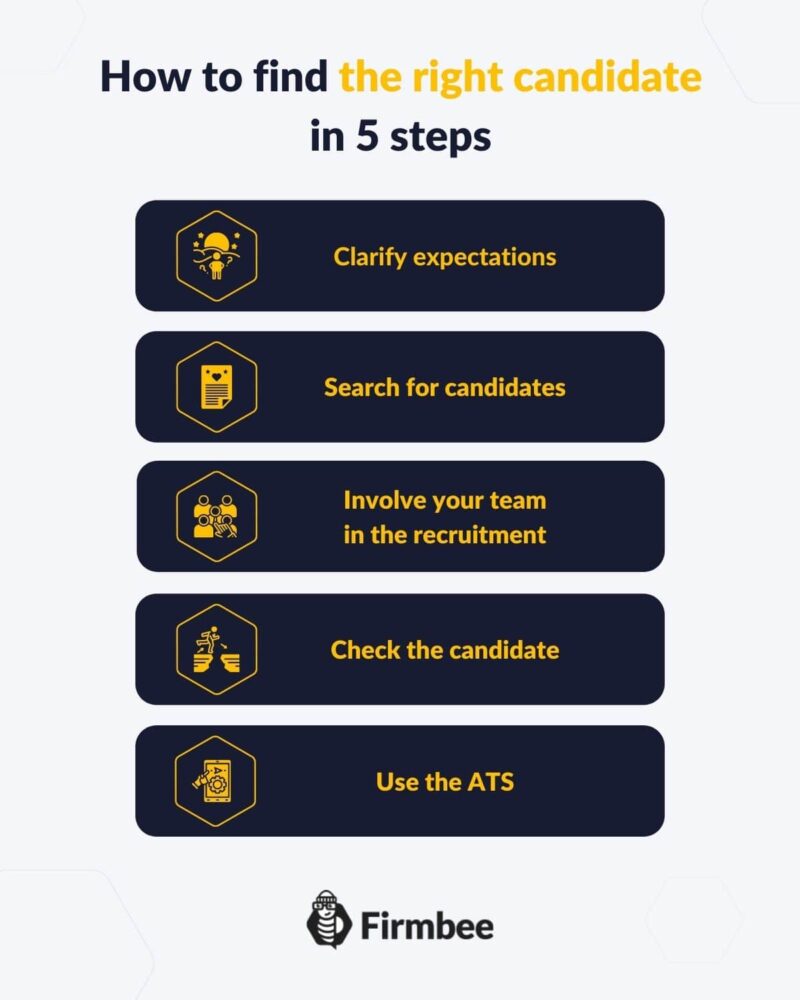Finding the right candidate for a job is not an easy task. There are many difficulties related to this process for recruiters. After all, during the interview itself, it’s difficult to determine whether the image and qualifications presented by the candidate do not differ from reality. So how to find the right candidate? There are several ways to do this, as described below.
How To Find The Right Candidate – table of contents:
- Clarify expectations
- Search for candidates
- Involve your team in the recruitment
- Check the candidate
- Use the ATS
Clarify expectations
The first step in finding and hiring the most suitable candidate is to clarify your own expectations. You need to determine the candidate’s profile, required characteristics, skills and experience. It is best to discuss it with the manager/client for whom we are hiring. They will be the future employer of our candidate, so we should let him actively participate in the recruitment process – especially at this initial stage of determining the requirements that the candidate has to meet. All necessary points that we settle with the manager/client should then be transferred to the job advertisement.
Search for candidates
With expectations clarified and a detailed offer written, depending on the position, industry and size of the company, the next step is to publish the ad.
Another option to consider is to tap into your contact database from previous recruitments – you may already have a matched candidate in your database who is still looking for a job and would be a good fit for your organization. Maybe you remember a former candidate who did not pass the recruitment process but would fit the position you are currently recruiting for? It’s a good idea to get in touch with this person even before the official publication of the ad online – it can significantly shorten the recruitment process and save your recruitment budget.

Another idea might be internal recruiting. Perhaps one of our employees would like to get reorganized in the near future or change teams. The biggest advantage of this practice (in addition to saving time and money) is that we already know the candidate, the recruiter can get to know the honest opinion of his supervisor and coworkers. In addition, such an employee is already in some way associated with the company, which reduces the risk that he or she will resign shortly after taking up the position.
Internal recruitment, however, is also associated with risks – disruption of the structure in the team from which we recruit an employee for a new position and lack of development, because a new employee coming from outside often brings a fresh perspective and ideas.
Another solution is to use employee referrals. Our employees are bound to have friends working in similar industries – even from their studies or previous jobs. Using employee referrals is a kind of balance between external and internal recruitment. We can acquire an employee from the outside, who will bring a new perspective to the company and the team, but is not a random person because before recruitment we can get to know the opinion about him given by a trusted employee.
Involve your team in the recruitment
Employees, apart from being able to recommend candidates for a given position, should also be involved in the recruitment process. They are the ones who know best what competencies they lack in the team. The prospective employee should share the same values as the team for their work to be effective.
Check the candidate
Before making a final decision, screen the candidate: review their LinkedIn profile, ask for recommendations from previous employers, try to reach out to former co-workers. During the recruitment process, check the declared skills and ask about the experience and details related to previous positions. This will help you find out if the candidate’s real skills and qualifications match those declared in the CV.
Use the ATS
To speed up and streamline the entire recruitment process, use the ATS (Applicant Tracking System). The system will allow you to automate many repetitive activities, so instead of completing formalities, you can focus on getting to know the candidate and successfully hire the person who fits the team and the organization you are recruiting for.
Read: How to write an effective job ad?
If you like our content, join our busy bees community on Facebook and Twitter.
Author: Nicole Mankin
HR manager with an excellent ability to build a positive atmosphere and create a valuable environment for employees. She loves to see the potential of talented people and mobilize them to develop.
The most important questions
-
What are the advantages of internal recruitment?
Lower recruitment costs, saving time and hiring a loyal employee we already know. Additionally, the possibility of promotion within the company builds a positive employee experience.
-
What are the disadvantages of internal recruitment?
Limiting oneself to "what is known", lack of fresh perspective on the team's product/work, risk of stagnation and lack of development.


















